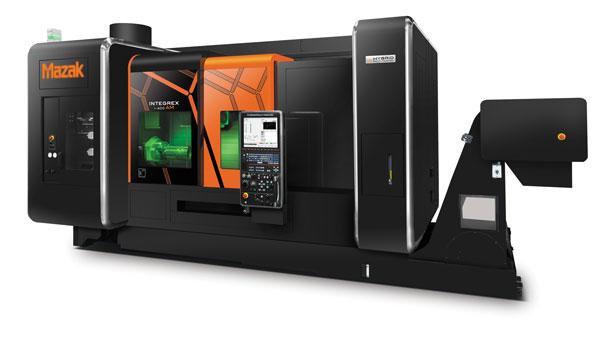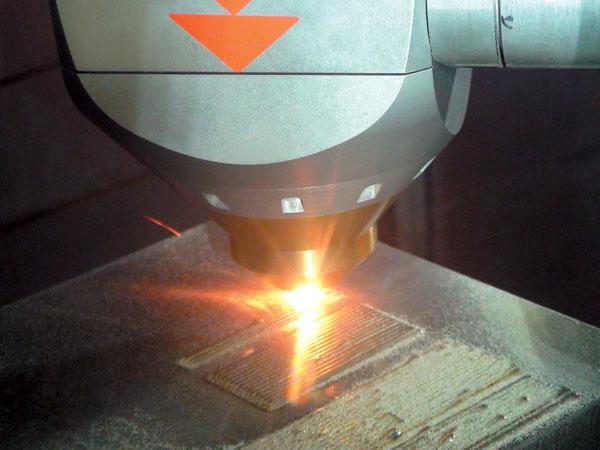- FMA
- The Fabricator
- FABTECH
- Canadian Metalworking
Technology Spotlight: Multitasking/Additive Manufacturing Machine
Machining system combines mill/turn subtractive machining and additive manufacturing in one platform
- By Joe Thompson
- June 18, 2015
- Article
- Metalworking

This hybrid additive/subtractive machine offers manufacturers an alternative to conventional processing in terms of part design and machining.
Additive manufacturing by definition builds parts by adding layers of material on top of each other. This is the opposite of traditional machining methods— subtractive manufacturing—which removes material from an existing block.
Another difference between the additive and subtractive methods of manufacturing is the complexity of the parts they are able to create in a relatively short amount of time. Parts with very complex geometries, including hollow parts, can be created using additive manufacturing with better results than with subtractive methods.
The reason for this difference is easy to see. With additive manufacturing, the part is “grown” layer by layer, laid down in a pattern a few thousandths of an inch at a time, and the process holds very high tolerances both inside and outside the part.
Typically, additive-built parts are used for prototyping, fit-up, and testing, while production runs of parts are best created using subtractive machining.
Now both types of manufacturing process have been included in a single work envelope.
Mazak Corp. has released the Integrex i-400AM Hybrid multitasking machine. It is a fusion of additive technology and the company’s multitasking equipment designed to reduce part cycle times while providing high-efficiency processing.
“This is a machine aimed at the OEM market,” explained Mazak Product Manager Joe Wilker. “Companies now are going to be able to move from the design stage to manufacturing one step faster. We now can produce net-shaped components or grow net-shaped features quickly and then machine them to precision tolerances.”
As a turnkey system, this hybrid additive/subtractive machine offers manufacturers an alternative to conventional processing in terms of part design and machining. The technology is suitable for small-lot production of difficult-to-cut materials, such as those used in the aerospace, energy, and medical industries.
With the additive capability, manufacturers can clad near-net-shape component features and then complete the part with precision finish machining operations. The parts even can be laser-marked using the system’s 2-kW laser.
“This machine is another step along the multitasking path the company has been on for many years,” said Wilker. “For years Mazak has been seeking to do more inside the work envelope of its traditional multitasking mill/turn machines, and this is another example of that thinking.”
Additive Manufacturing
In operation, the machine melts metal powder using fiber laser heat. Cladding heads (the additive manufacturing nozzles) apply the molten material layer by layer, each of which solidifies as the desired shape grows.
“In the back of the machine is a powder feeder that can be loaded with multiple powder canisters,” said Wilker. “This leads to a funnel and the powder moves through a small hole to a rotary disc that flings the powder into the air, where pressurized argon gas picks it up and takes it to the cladding head. At that point the 2-kW laser focuses and melts the powder.”
In addition, the system can join different types of metals to one another, a capability beneficial in the repair of existing worn or damaged components, such as aerospace turbine blades.
The cladding heads are stored in the machine’s tool magazine when not in use, and the standard automatic tool changer (ATC) loads them into the machine’s milling turret. The company offers two types of cladding heads—high speed and high accuracy. Users select the appropriate head based on the intended process and the particular metal powder to be used.
“Machinists can switch from additive to subtractive machining in less than one minute,” said Wilker.
On the multitasking side, the machine provides full 5-axis capability to process prismatic parts from solid billets or castings, which can be either chucked or bar-fed; round parts; contoured parts; and now those with features built using additive technology.
It provides -30- to +210-degree Baxis movement in its milling spindle, full C-axis contouring with its turning spindle, and a fully programmable NC tailstock.
subscribe now


Keep up to date with the latest news, events, and technology for all things metal from our pair of monthly magazines written specifically for Canadian manufacturers!
Start Your Free Subscription- Trending Articles
- Industry Events
MME Winnipeg
- April 30, 2024
- Winnipeg, ON Canada
CTMA Economic Uncertainty: Helping You Navigate Windsor Seminar
- April 30, 2024
- Windsor, ON Canada
CTMA Economic Uncertainty: Helping You Navigate Kitchener Seminar
- May 2, 2024
- Kitchener, ON Canada
Automate 2024
- May 6 - 9, 2024
- Chicago, IL
ANCA Open House
- May 7 - 8, 2024
- Wixom, MI
















